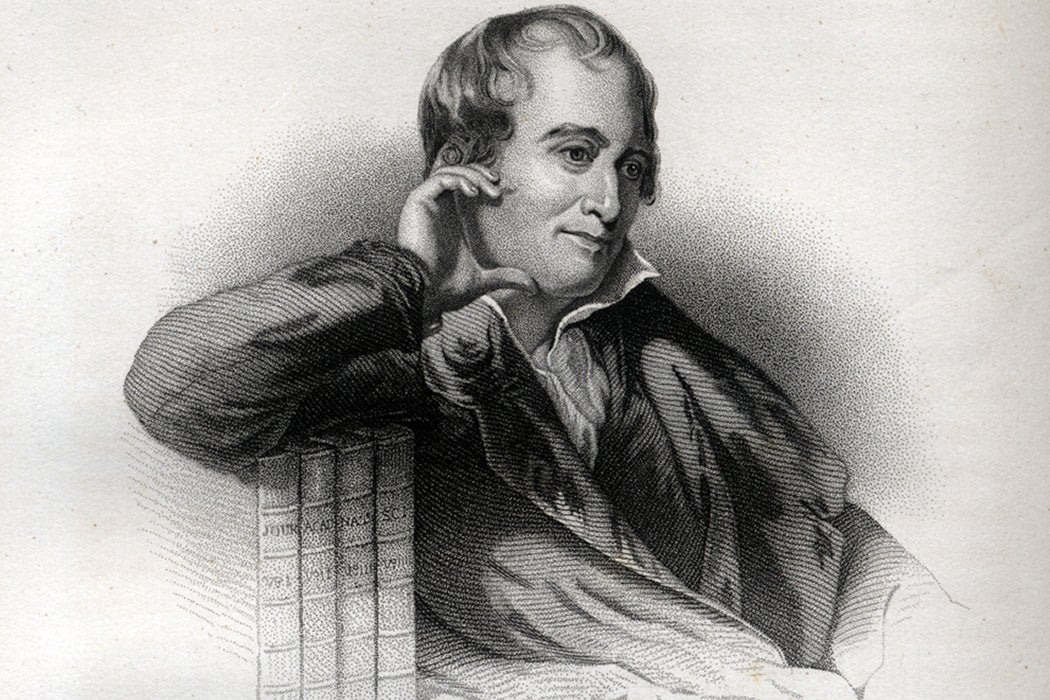In the winter of 1825–1826, the president, librarian, and several members of the Philadelphia Academy of Sciences headed west from Pittsburgh on the Ohio River. Academy President William Maclure, “father of American geology,” had gathered them all aboard the keelboat Philantropist [they used the French spelling]: scientists, artists, musicians, and educators, some bringing along their students, and all were eager to settle in Robert Owen’s New Harmony community on the Indiana frontier.
Owen described it as a “Boatload of Knowledge.” A Welsh-born Scottish textile mill owner, social reformer, utopian, and early socialist, the already-renowned Owen wanted to establish a “New Moral World” in the New World. As scholar Donald E. Pitzer elucidates,
This would be a world of enlightenment and prosperity leading to human happiness, which Owen defined as mental, physical, and moral health enjoyed in a a rational way of life. It would displace the Old Immoral World of ignorance, superstition, selfishness, and suffering intensified by the first wave of the Industrial Revolution.
Education was fundamental to Owen’s vision. Maclure’s recruits were to be the nucleus of the utopia on the Wabash River. But first they had to get there. It took a month and a half to travel down the wintery Ohio. The keelboat got stuck in the ice and ran aground on mud. There were near-drownings. The ladies helped row. Owen himself began the trip with the group but disembarked to finalize the purchase of the New Harmony property. (The Harmony Society had been established by a Lutheran sect led by German immigrant George Rapp in 1814. A decade later, the Rappites quit Indiana and moved east to a new community in Pennsylvania called Economy. Owen swept up the tidy little village in a utopian fire sale.)
Besides Maclure, the forty passengers included Thomas Say, the Academy of Sciences’s Librarian. An all-around naturalist who produced major studies of American herpetology, entomology, and conchology, Say ended up marring Lucy Way Sistare, who been one of the students on the boat. Lucy Say did most of the now highly collectable art of Say’s landmark American Conchology (1830–1838), which was first published in New Harmony. She was also the first women elected into the Academy of Natural Sciences of Philadelphia.
Charles-Alexandre Lesueur, French naturalist and educational reformer, was on board, drawing constantly. He produced a major work with American Ichthyology (1827), also published by New Harmony presses. Lesueur’s thousand-plus pen and ink sketches of the American scene—more than one hundred of them from the trip down the Ohio—are now an invaluable look at the America of the day. Fellow passengers William S. Phiquepal and Marie Louise Duclos Fretageot brought the educational precepts of Swiss education pioneer Johann Heinrich Pestalozzi—learn by doing—to New Harmony.
Utopia means “no place,” so it may not be surprising that New Harmony was unsuccessful as a utopian community. But Maclure’s “Boatload of Knowledge” had a lot influence, especially in educational matters. The community provided free co-educational schooling for children from infancy to adulthood half a century before the state mandated it. The School of Industry, Maclure’s big project (he had hated his own classical education), “pioneered the trade school concept in this country.”
“Measured by the libraries, schools, research, and publications that the ‘Boatloaders’ produced in the decades ahead, few could question that the promise was kept,” writes Pitzer. “Scientific, cultural, social, and economic benefits were realized not only by New Harmony, but also by the Midwest and nation at large.”
Weekly Newsletter
Robert Owen was mostly a stranger to New Harmony, but several of his children lived there. Robert Dale Owen, who came with the original Philantropist passengers, served in the Indiana General Assembly and as a US Congressman. David Dale Owen was the first American to survey the geology of Arkansas, Indiana, Iowa, Kentucky, Minnesota, and Wisconsin. Richard Owen, also a geologist, was a professor at Indiana University and later the first president of Purdue University.
New Harmony definitely punched above its weight as a center of American science and education, all because a literal boatload of knowledge had disembarked on the banks of the Wabash—dreaming of utopia, certainly, but more than practical when they got down to work.







